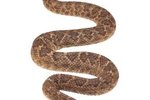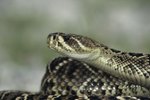
The 36 known rattlesnake species live only in North and South America. The sidewinder rattlesnake is indigenous to desert regions across southeastern California, southern Nevada, southwestern Utah, western Arizona and northwestern Mexico. Sidewinder rattlesnakes are venomous, but of little threat to humans, except for young children. The toxin is capable of killing an animal weighing up to 30 pounds; in a larger animal or grown human, it typically causes transient pain, swelling, and general symptoms of illness.
Appearance
Sidewinder rattlesnakes grow to about 25 inches long and are approximately the color of sand, which helps them conceal themselves in their desert habitat. They may have a pinkish, yellowish or grayish tint, and they feature speckles along their sides and about 40 dark patches down their backs. They have broad triangular heads, thin necks, thick bodies, and small rattles made of keratin at their tail end. These snakes also have little holes known as pits near their eyes, which function as heat sensors for detecting prey. Sidewinders are also known as horned rattlesnakes because of the upturned protruding scales above their eyes, a feature unique to this species among all the types of rattlesnakes.
Diet
Sidewinder rattlesnakes are carnivorous. Lizards make up the majority of young sidewinders' diets. When they mature, small rodents, including mice, kangaroo rats and other burrowing creatures, become a dietary staple. These snakes also eat small birds, reptiles and other mammals when a convenient opportunity presents itself. They hunt by ambush, hiding beneath the sand with just their heads slightly exposed. When prey comes into range, they strike, biting and releasing deadly venom. They follow the animal with the sidewinding motion from which they take their name, swallowing it whole as it dies.
Behavior
Solitary by nature, sidewinder rattlesnakes travel alone across their desert home. Because they are cold-blooded reptiles, they rely on the sun for warmth but are also especially vulnerable to overheating in the harsh desert atmosphere. During hot seasons, these snakes are most active during twilight hours and overnight, seeking shade or burrowing into the sand for shelter while the sun beats down. They become more active during the day in cooler weather, but hibernate through the coldest part of the winter. Like all rattlesnakes, sidewinders shake their rattles as a warning when they feel threatened. They live between 20 to 30 years in captivity, but aren't likely to survive that long in the wild.
Reproduction
These snakes primarily mate from April through May. Females reproduce once every two or three years, giving birth to live offspring in the late summer or early fall. To initiate breeding, a male crawls over the female's back, stroking her with his chin to stimulate arousal. The male wraps his tail around the female's, aligning their sex organs, and the female lifts her tail to facilitate breeding if she is so inclined. Mating generally lasts several hours. The female gives birth to about 15 to 18 offspring in a period of two to three hours. Babies range from 6 to 8 inches long, on average, and break out of a thin membrane within a few minutes of birth. The babies remain at their birth site for a few days, then go off on their own without subsequent contact with family members.
References
Photo Credits
-
Jupiterimages/Photos.com/Getty Images
Writer Bio
Eric Mohrman has been a freelance writer since 2007, focusing on travel, food and lifestyle stories. His creative writing is also widely published. He lives in Orlando, Florida.


